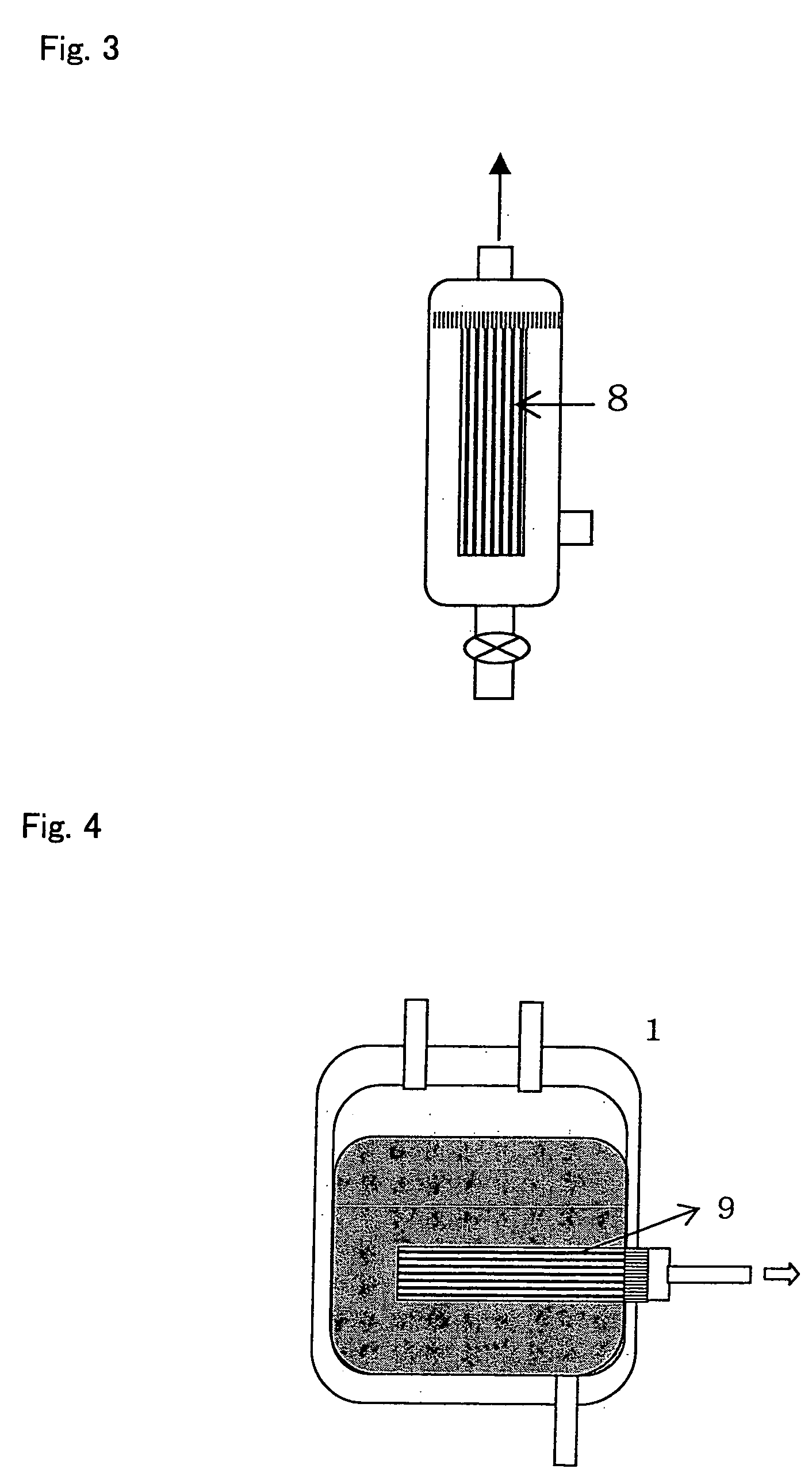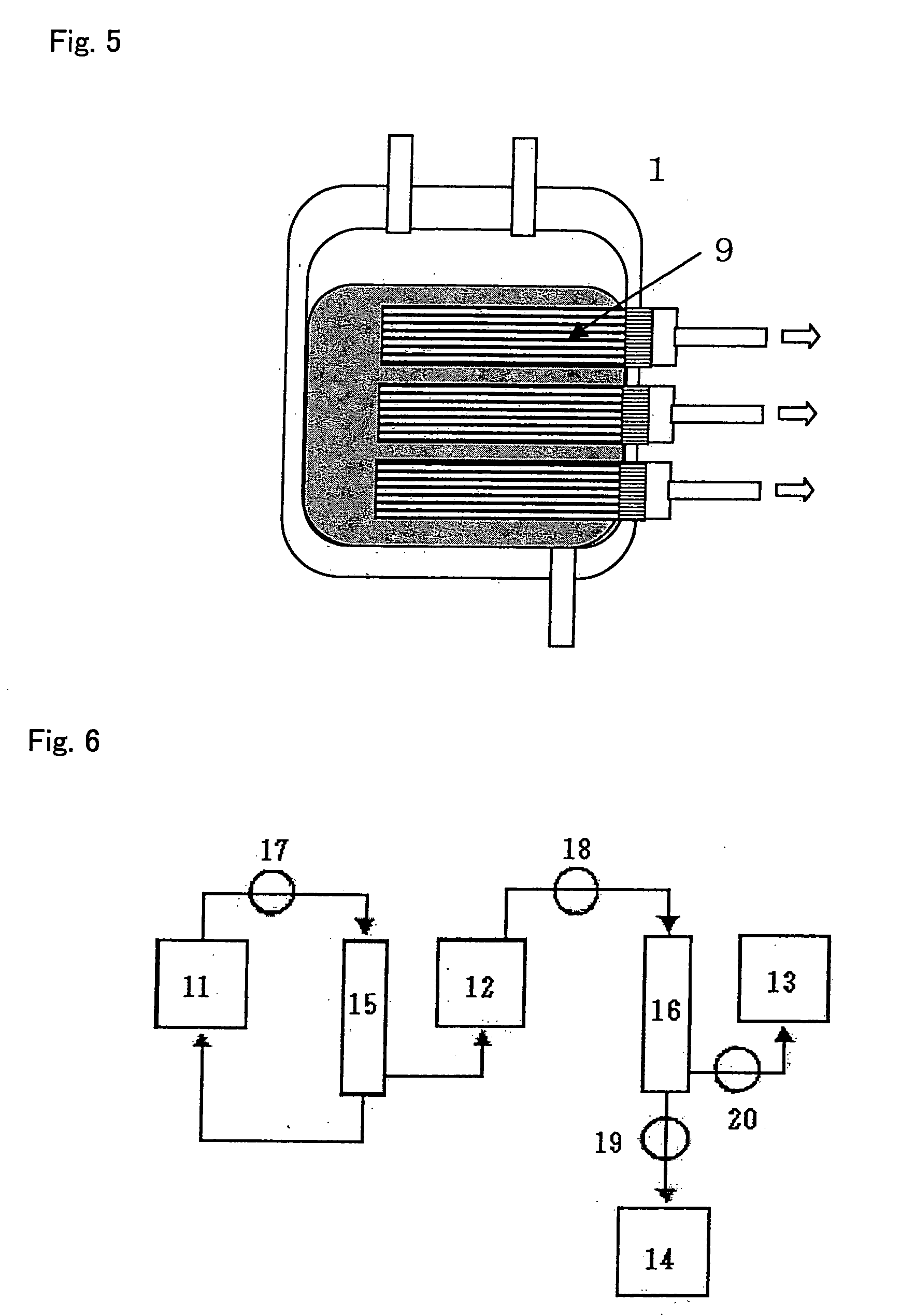Fibrin-containing composition
a composition and fibrin technology, applied in the field of fibrin-containing compositions, can solve the problems of inability to obtain sufficient water-permeable effect, inability to introduce plasma into the device, inability to achieve sufficient fibrinogen concentration, etc., and achieve the effect of rapid and simple production and high performan
- Summary
- Abstract
- Description
- Claims
- Application Information
AI Technical Summary
Benefits of technology
Problems solved by technology
Method used
Image
Examples
example 1
Preparation of Fibrinogen Concentrate by Improved Cryo Method and Production of Fibrin-Containing Biological Scaffold
[0117] 400 ml of fresh blood collected from a healthy subject [to which 56 ml of CPD (Citrate-phosphate-dextrose C7165 manufactured by Sigma-Aldrich Inc.) had been added as an anticoagulant] was dispersed into aliquotes into a 50-ml centrifuge tube (No. 352070 manufactured by Nippon Becton Dickinson Co. Ltd.), followed by centrifugation (1,000 g×15 minutes, 4° C.) (No. 3740 manufactured by KUBOTA Corp.), so as to obtain 235 ml of plasma. The obtained plasma was then transferred into a freezer (EEV-204N manufactured by Whirlpool Corp.), and it was left at rest at −27° C. for 30 minutes, so as to freeze it. Thereafter, the centrifuge tube containing frozen plasma was transferred into a refrigerated centrifuge having a chamber temperature of −2.5° C. (No. 3740 manufactured by KUBOTA Corp.), and it was then left in chamber for 30 minutes. Subsequently, the centrifuge tub...
example 2
Preparation of Fibrinogen Concentrate by Improved Cryo Method (another method) and Production of Fibrin-Containing Biological Scaffold
[0118] 40 ml of fresh blood collected from a healthy subject [to which 5.6 ml of CPD (Citrate-phosphate-dextrose C7165 manufactured by Sigma-Aldrich Inc.) had been added as an anticoagulant] was placed in a 50-ml centrifuge tube (No. 352070 manufactured by Nippon Becton Dickinson Co. Ltd.), followed by centrifugation (1,000 g×15 minutes, 4° C.) (No. 3740 manufactured by KUBOTA Corp.), so as to obtain 20.5 ml of plasma. The obtained plasma was then transferred into a freezer (EEV-204N manufactured by Whirlpool Corp.), and it was left at rest at −30° C. for 60 minutes, so as to freeze it. Thereafter, the centrifuge tube containing frozen plasma was left at rest in a refrigerated centrifuge having a chamber temperature of −5° C. (No. 3740 manufactured by KUBOTA Corp.) for 30 minutes. Subsequently, it was left at rest in a refrigerator (Medicool MPR-510 ...
example 3
[0131] A fibrinogen concentrate was prepared from human plasma by a method equivalent to that in Example 1 (improved cryo method) and the hollow fiber membrane method.
[0132] 50 ml of pooled plasma collected from healthy subjects (derived from multiple donors) [which had been prepared by centrifuging peripheral blood added with 56 ml of CPD as an anticoagulant (Citrate-phosphate-dextrose C7165 manufactured by Sigma-Aldrich Inc.) to 400 ml of the blood] was transferred into a 50-ml centrifuge tube (No. 352070 manufactured by Nippon Becton Dickinson Co. Ltd.). The centrifuge tube was then left at rest in a freezer (EEV-204N manufactured by Whirlpool Corp.) at −27° C. for 30 minutes, so as to freeze it. Subsequently, the centrifuge tube containing frozen plasma was transferred into a refrigerated centrifuge, the chamber temperature of which had been set at −2.5° C. (No. 3740 manufactured by KUBOTA Corp.), and it was then left for 30 minutes. Subsequently, the centrifuge tube was transf...
PUM
| Property | Measurement | Unit |
|---|---|---|
| temperature | aaaaa | aaaaa |
| temperature | aaaaa | aaaaa |
| temperature | aaaaa | aaaaa |
Abstract
Description
Claims
Application Information
 Login to View More
Login to View More - R&D
- Intellectual Property
- Life Sciences
- Materials
- Tech Scout
- Unparalleled Data Quality
- Higher Quality Content
- 60% Fewer Hallucinations
Browse by: Latest US Patents, China's latest patents, Technical Efficacy Thesaurus, Application Domain, Technology Topic, Popular Technical Reports.
© 2025 PatSnap. All rights reserved.Legal|Privacy policy|Modern Slavery Act Transparency Statement|Sitemap|About US| Contact US: help@patsnap.com



